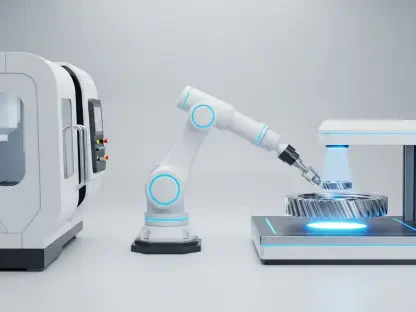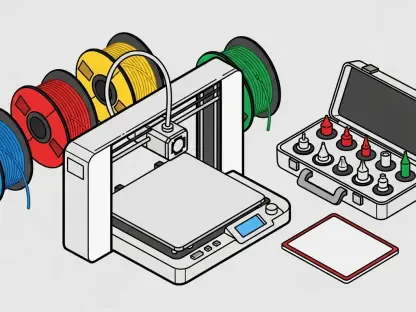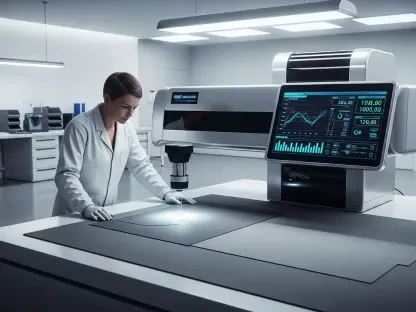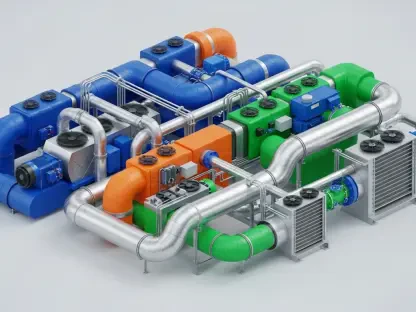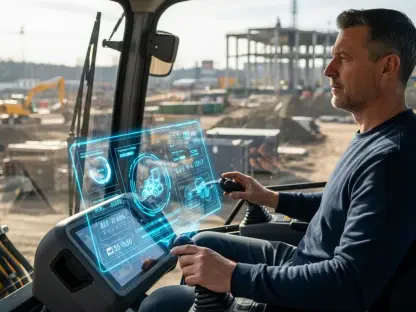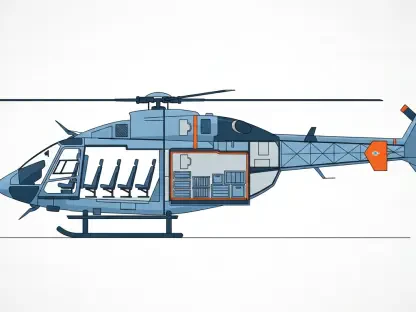In an era where artificial intelligence is reshaping the technological landscape, NVIDIA stands as a colossus, long celebrated for its dominance in AI chips and data center solutions, but now it’s turning heads with a daring pivot into robotics. As the demand for traditional AI hardware is anticipated to reach its peak soon, this strategic shift could mark a defining moment for the company, positioning it at the forefront of the next industrial revolution. Robotics, blending AI with physical automation, offers a tantalizing promise to transform sectors ranging from manufacturing to healthcare, and NVIDIA seems poised to lead this charge. This bold move isn’t merely a diversification tactic; it represents a calculated effort to tap into a burgeoning market where innovation meets real-world application. With cutting-edge technology and a robust ecosystem, the company is not just adapting to change but actively shaping the future of industrial automation, raising the question of whether this segment could become its most significant growth engine yet.
Pioneering Tech: Closing the Virtual-to-Real Divide
NVIDIA’s foray into robotics is anchored by its innovative approach to overcoming one of the toughest hurdles in AI: translating simulations into real-world functionality. The company’s closed-loop system, encompassing training, simulation, and deployment, ensures that AI models continuously evolve through real-time data feedback. Tools like Isaac Sim 5.0 and the Omniverse platform empower developers to test robotic tasks in virtual environments before physical implementation, drastically cutting costs and accelerating deployment timelines. A prime example is the Isaac GR00T N1.5 model, tailored for humanoid robots, which adapts to unpredictable settings with remarkable precision. This technological prowess positions NVIDIA as a critical player in enabling industries to adopt automation seamlessly, bridging a gap that has long hindered progress in robotics.
Complementing its software innovations, NVIDIA’s hardware solutions are equally transformative, driving the robotics sector forward with unmatched computing power. The Jetson AGX Thor module, a compact powerhouse, delivers AI capabilities that are integral to modern robotic systems, from autonomous drones to industrial machinery. This hardware fuels a self-reinforcing cycle where enhanced AI models demand more advanced components, perpetuating NVIDIA’s relevance in the market. Unlike traditional tech approaches that focus on isolated solutions, this integrated ecosystem ensures that every advancement in software or hardware amplifies the other, creating a dynamic growth loop. Such a strategy not only solidifies NVIDIA’s standing in robotics but also sets a high barrier for competitors attempting to replicate this comprehensive approach, hinting at a sustained technological edge.
Global Alliances: Crafting a Robust Robotics Network
Collaboration lies at the heart of NVIDIA’s robotics strategy, with partnerships spanning industry giants like Toyota, KUKA, and Universal Robots embedding its technology into diverse applications. These alliances are more than mere business deals; they represent a shared vision of integrating AI-driven automation across sectors such as manufacturing, logistics, and autonomous vehicles. By working closely with these leaders, NVIDIA ensures that its solutions are tailored to specific industry needs, enhancing adoption rates and scalability. The result is a sprawling ecosystem where NVIDIA’s hardware and software become the backbone of cutting-edge robotic systems, from collaborative robots on factory floors to self-driving platforms navigating complex environments, amplifying its global influence.
Beyond individual partnerships, NVIDIA is investing in expansive infrastructure to support the robotics revolution on a worldwide scale. A notable initiative is the European industrial AI cloud, equipped with 10,000 GPUs, launched to bolster digital twins and AI-driven design for manufacturers across the continent. This sovereign infrastructure not only supports regional industries but also positions NVIDIA as a key enabler of automation at a macro level, fostering innovation in robotics and beyond. Such efforts underscore a commitment to not just participate in the market but to shape its very foundation, ensuring that NVIDIA’s technologies are integral to the future of industrial automation. This global network of partnerships and infrastructure projects signals a strategic intent to dominate the robotics landscape through collaboration and scale.
Financial Trajectory: A Rising Star in Revenue Streams
Despite currently representing a small fraction of NVIDIA’s overall revenue, the robotics and automotive segment is demonstrating explosive growth, with a reported 72% year-over-year increase to $567 million in the first quarter of the current fiscal year. This surge, though modest in the context of the company’s broader portfolio, hints at immense potential as markets for autonomous vehicles and industrial robotics are projected to reach $214 billion and $35 billion by 2030, respectively. Holding a commanding 90% share in self-driving car platforms and powering half of industrial robots with its software, NVIDIA is strategically positioned to capture a substantial portion of these expanding markets. This financial uptick suggests that what begins as a niche could soon evolve into a cornerstone of the company’s revenue base.
Looking deeper into the financial implications, NVIDIA’s early dominance in these high-growth areas offers a glimpse into a future where robotics could rival its traditional AI chip business. The scalability of products like the Jetson AGX Thor across millions of robots in sectors such as healthcare, agriculture, and retail further fuels optimism about sustained growth. Unlike other segments where market saturation might loom, robotics presents a relatively untapped frontier, ripe with opportunities for expansion. As industries increasingly adopt automation to enhance efficiency, NVIDIA’s foothold in providing the underlying technology could translate into significant financial gains, potentially reshaping investor perceptions of its long-term value proposition in a tech landscape hungry for innovation.
Sustainable Strategies: Building for the Future
NVIDIA’s vision for robotics extends far beyond immediate gains, focusing on sustainable business models like Robotics as a Service (RaaS), which prioritizes recurring revenue over traditional one-time hardware sales. This shift, exemplified by collaborations such as with North Foundry Inc. on warehouse automation robots, offers scalable and cost-effective solutions that appeal to a broad range of industries. By transitioning to subscription-based models, NVIDIA ensures a steady income stream while fostering deeper customer relationships through ongoing service and updates. Such a forward-thinking approach not only aligns with industry trends toward service-oriented tech but also positions the company to weather market fluctuations with greater resilience, securing its place in the automation ecosystem.
Equally critical to this long-term strategy is NVIDIA’s hefty investment in research and development, with $4.5 billion allocated in the first quarter of the current fiscal year alone. This funding powers ambitious projects like Project GR00T for humanoid AI and Isaac AMR for autonomous mobile robots, initiatives that could redefine entire sectors. Unlike competitors who may focus on incremental improvements, NVIDIA’s R&D efforts aim at foundational breakthroughs, targeting the automation of the physical world in ways previously unimagined. This commitment to innovation signals an intent to lead rather than follow, ensuring that NVIDIA remains at the cutting edge of robotics technology. As these projects mature, they promise to unlock new markets and applications, further solidifying the company’s role as a pioneer in industrial transformation.
Challenges Ahead: Balancing Risks with Opportunities
Even with its promising trajectory, NVIDIA’s robotics venture is not without obstacles, including geopolitical tensions and export restrictions, particularly concerning markets like China. These challenges could hinder growth in key regions, potentially impacting revenue from international sales of robotics tech. However, the company is actively mitigating such risks by developing region-specific solutions, such as tailored chips for restricted markets, while diversifying income across data centers, gaming, and automotive sectors. This strategic adaptability demonstrates a keen awareness of global dynamics, ensuring that NVIDIA remains agile in navigating complex trade landscapes while maintaining its competitive edge in robotics innovation.
On the flip side, opportunities abound as regulatory environments in the U.S. and EU increasingly support autonomous systems through safety standards and incentives, creating a favorable backdrop for NVIDIA’s technologies. Emerging competition from other AI chipmakers poses a threat, yet NVIDIA’s comprehensive ecosystem and early market dominance provide a buffer against such challenges. Unlike newer entrants who may struggle with scale, NVIDIA’s established partnerships and technological lead offer a significant advantage. This balance of risk and opportunity highlights a nuanced path forward, where proactive strategies and supportive policies could pave the way for accelerated adoption of robotics solutions, reinforcing NVIDIA’s position in this transformative field.
Reflecting on Progress: Steps Toward an Automated Tomorrow
Looking back, NVIDIA’s journey into robotics reveals a calculated yet ambitious pivot that tackles the plateauing demand for AI chips head-on, carving out a new path in industrial automation. Strategic partnerships have been forged with industry leaders, while technological innovations like the Isaac GR00T model and Jetson AGX Thor module set benchmarks in the field. Financially, the segment shows remarkable growth, and long-term visions through RaaS and hefty R&D investments lay a solid foundation for sustained success. Despite navigating risks like export barriers, adaptive measures and regulatory support help balance the scales. Moving forward, stakeholders should monitor how NVIDIA scales its global infrastructure and refines recurring revenue models to solidify its robotics foothold. Exploring deeper collaborations and pushing the boundaries of AI integration in physical systems will be crucial next steps to ensure this promising growth driver transforms into a lasting pillar of innovation.



